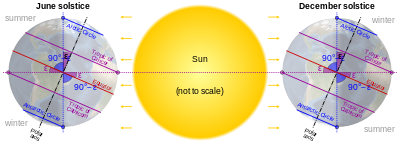Polar circle
This article needs additional citations for verification. (December 2016) |



A polar circle is a geographic term for a conditional circular line (arc) referring either to the Arctic Circle or the Antarctic Circle. These are two of the keynote circles of latitude (parallels). On Earth, the Arctic Circle is currently drifting northwards at a speed of about 14.5 m per year and is now at a mean latitude (i.e. without taking into account the astronomical nutation) of 66°33′49.9″ N; the Antarctic Circle is currently drifting southwards at a speed of about 14.5 m per year and is now at a mean latitude of 66°33′49.9″ S.[1] Polar circles are often equated with polar regions of Earth. Due to their inherent climate environment, the bulk of the Arctic Circle, much of which is sea, is sparsely settled whereas this applies to all of Antarctica which is mainly land and sheltered ice shelves.
If Earth had no atmosphere then both polar circles (arcs) would see at least a day a year when the center of the Sun is continuously above the
The latitude of the polar circles is + or −90 degrees (which refers to the North and South Pole, respectively) minus the
Correspondence to polar night and day

The polar circles would almost precisely match the boundaries for the zones where the
See also
- Antarctica
- Antarctic Circle
- Arctic
- Arctic Circle
- Frigid zones
- Polar climate
- Polar day and Polar night
- Polar region
Notes
- ^ Obliquity of the ecliptic Archived 2017-06-12 at the Wayback Machine
- ^ Swedish Astronomic calendar 2003 (or any other year) at the times of the winter and summer solstices, around 22 June and 22 December

